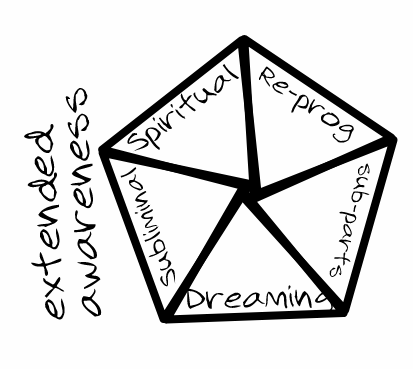Extended Awareness
Extended Awareness
Extended Awareness:
This area is about what lays beyond the subjective. This are common spaces for many approaches, but they are not so easily grasped by a client or a therapist in training. They usually need many experiences and theoretical knowledge to use and understand.

🛌 Dreaming:
Dreaming and other dreamlike experiences have been a staple in psychotherapy since Freud’s Interpretation of Dreams. There are many ways of approaching dreams and working with them.
Traditionally we would interpret the symbols, but we can also amplify the archetypes, do active imagination, enact them individually or in groups, write them as narrative, etc.
Dreams open to use a space to the unconscious and the metaphoric areas of our minds.
⏱️ Subliminal:
Subliminal work also has been in the field since its origins, with hypnosis being what Freud trained in and left behind. It was Milton Erikson who brought back the technique, when he would tell stories to children to help them stop wetting their beds.
The many stories of Erikson lead him to be part of ‘The Structure of Magic’ the seminal book that created Neurolinguistic Programming. He never wrote theories of his work, but it has been an inspiration for many approaches, as he was able to use subliminal techniques to influence clients, with them being conscious in the process.
It includes the use of non-verbal communication, the soft trance of storytelling, association with objects/situations/people, use of embodied/enacted metaphors, etc.
🎭 Sub Parts:
The work with parts is common in more humanistic approaches, like the Gestalt. For some authors this seems like a dissociation, and clients sometimes get scared of having multiple personalities.
In the practice it is useful to give voice to the different tendencies of our clients, and to open space for them to express what they are wanting to say. An open conversation, with awareness and a therapist holding the contradictions and conflicts, help clients to dissolve and integrate their subtle dissociations.
Paraphrasing James Hillman: personification seems to be a natural way of the mind, that lead us to more complex ways of thinking.
🙏 Spiritual:
Using this name may be contentious for evidence based therapist, but I think it encapsulates many of our therapeutic assumptions. It does not aim to belong to any religious tradition, but many therapist come to work inspired by their religions, spirituality and the compassion they learned there.
I include in this group the notion that we have a natural tendency towards growth. I also expand it to the use of alternative states of consciousness, meditation, and spiritual healing. These areas are so prevalent in our practice, and somewhat adjacent practices, that I feel they need to be included in a more open therapeutic way of thinking.
Transpersonal Psychology has studied and generated practices that bring spirituality to the current discussions of the field, addressing how to understand alterated states in relation to psychiatry and psychotherapy.
📠 Re-programming:
This group is usually more pragmatic, and aims to generate associations by actively repeating actions, or using objects that represent a desired mental state. An example is to imagine a safe place and then carry a stone that represents that state.
This type of practices somewhat ‘re-program’ our system. Their main representative is NLP, but we can find it in other practices as well. I have seen many therapist using EMDR which it also aims to break connections with traumatic experience by moving our eyes in different directions.
These types of approaches I call ‘re-programming’ because they directly address associations and learning, aiming to change a pattern directly.